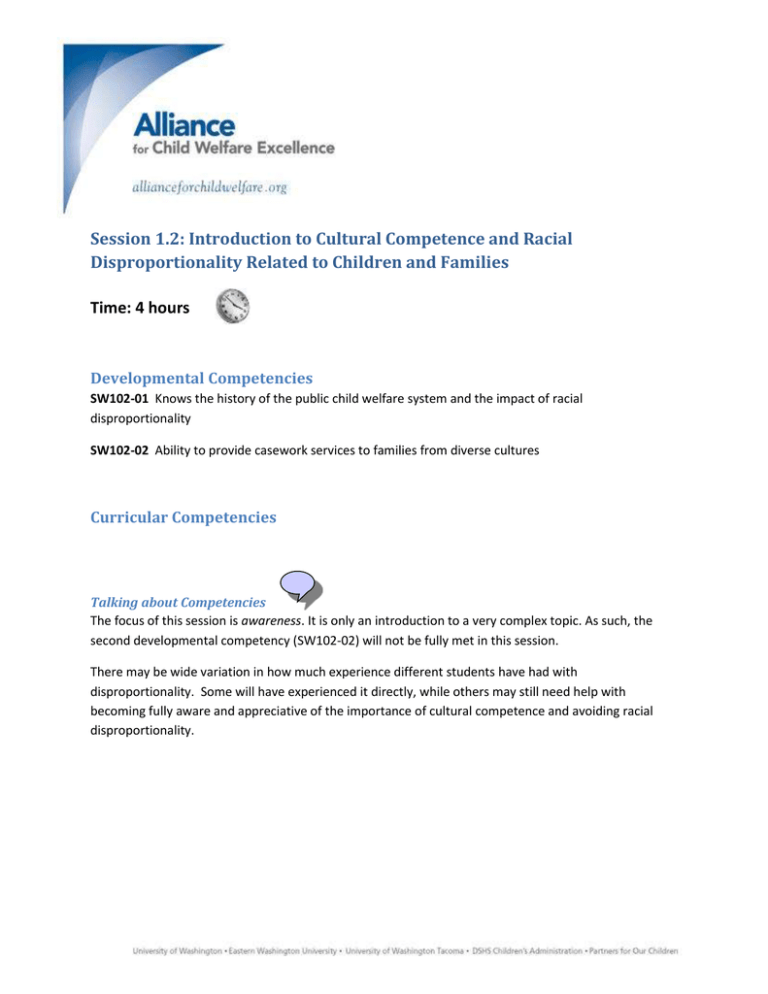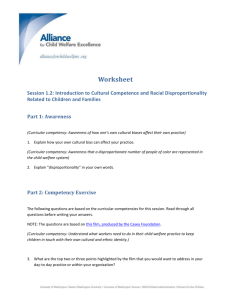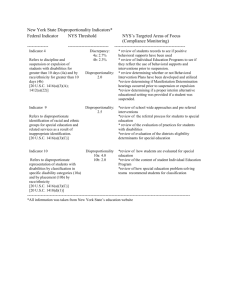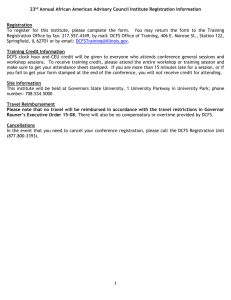1.2 Intro to Cultural Competence Curriculum
advertisement

Session 1.2: Introduction to Cultural Competence and Racial Disproportionality Related to Children and Families Time: 4 hours Developmental Competencies SW102-01 Knows the history of the public child welfare system and the impact of racial disproportionality SW102-02 Ability to provide casework services to families from diverse cultures Curricular Competencies Talking about Competencies The focus of this session is awareness. It is only an introduction to a very complex topic. As such, the second developmental competency (SW102-02) will not be fully met in this session. There may be wide variation in how much experience different students have had with disproportionality. Some will have experienced it directly, while others may still need help with becoming fully aware and appreciative of the importance of cultural competence and avoiding racial disproportionality. RCT 1.2: Introduction to Cultural Competence and Racial Disproportionality Related to Children and Families Materials and Preparation Students will need to access Canvas, and be able to watch a video off the internet. Handouts and Websites DSHS Racial Disproportionality Website Report on Racial Disproportionality in Washington’s Child Welfare System – 2nd Edition Knowing Who You Are video Session Flow COACHES NOTE: This session is done almost entirely in Canvas. It may be combined with other sessions in Module 1, such that starting the activity and discussing and debriefing are done together. Make sure RCT participants are aware of the need to complete the associated assignment prior to the scheduled debrief session so the assignment can be reviewed as a group and used to guide discussions around Disproportionality and Cultural Competence. Step Delivery Method Time 1 Introduce the assignment to students Phone or in person 1-5 minutes 2 Students complete the worksheet assignment Students complete the Knowing Who You Are online activity Discussion and debrief (discuss students responses to questions) Canvas 2 hours Canvas 1 hour With the cohort as a group, combined with another RCT Module 1 session. 30 minutes to 1 hour 3 4 Page 2 of 4 RCT 1.2: Introduction to Cultural Competence and Racial Disproportionality Related to Children and Families Session 1.2 Coach’s Notes [Answers and feedback tips for coaches will appear in red, when available.] 1.2.1 Visit DSHS webpage on Disproportionality in Child Welfare: In 2007, the Washington State Racial Disproportionality Advisory Committee was formed to explore the root causes of and make recommendations for remediation of the racial disproportionality and disparity in Washington State. Please visit the DSHS Racial Disproportionality Website and answer the following questions: 1. Racial disproportionality is defined as: a. That certain racial groups are under-represented in the child welfare system. b. That Caucasian children are over-represented in the child welfare system. c. The over-representation of children of color in the child welfare system, compared to their numbers in the population. 1.2.2 Review the Report on Racial Disproportionality in Washington’s Child Welfare System – 2nd Edition and answer the following questions. (From the Executive Summary) 1. The greatest disproportionality a. b. c. d. for children of color occurs when (check all that apply): The initial referral is made Intake screens the call and decides whether it should receive agency response The decision to remove the child from home is made A child is in care for over two years 2. Children in households headed by single parents are more likely to be in foster care. True False 3. After referral, a. b. c. d. when compared to White/Caucasian children Black/African American children are: Less likely to have a referral accepted Not as likely to reunify with parents in two years More likely to be assessed high-risk at intake None of the above. (From Chapter 2-Literature Review) 4. Casey Family Programs has identified several practices that may improve outcomes for children and families of color who are already involved with the child welfare system. One involves families in the decision-making process which increases the potential for enabling extended family to gain custody of children. This is referred to as Family Group Conferencing. Page 3 of 4 RCT 1.2: Introduction to Cultural Competence and Racial Disproportionality Related to Children and Families 5. The domination of one social racial or ethnic group over another is referred to as Racism. 1.2.3 View the film Knowing Who You Are created by Casey Family Programs. Answer the following questions: 1. How can you further integrate racial and ethnic identity work with youth into your day-to-day practice or within your organization? What are some possible ways to maintain or rebuild cultural, ethnic, and racial connections for youth who are in care? Various answers, utilize this question to encourage reflection and sharing of ideas/resources. 2. What are some possible ways to maintain or rebuild cultural, ethnic, and racial connections for youth who are in care? Various including: relative placement, establishing paternity/father engagement, relative search, visitation, connection with religious/spiritual groups, participation in cultural activities, ensuring the child’s school environment reflects people from similar backgrounds as the child, providing information about the child’s backgrounds, etc… Page 4 of 4








